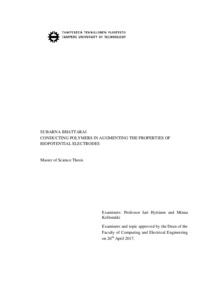Conducting Polymers in Augmenting the Properties of Biopotential Electrodes
Bhattarai, Subarna (2017)
Bhattarai, Subarna
2017
Electrical Engineering
Tieto- ja sähkötekniikan tiedekunta - Faculty of Computing and Electrical Engineering
This publication is copyrighted. You may download, display and print it for Your own personal use. Commercial use is prohibited.
Hyväksymispäivämäärä
2017-06-07
Julkaisun pysyvä osoite on
https://urn.fi/URN:NBN:fi:tty-201705241471
https://urn.fi/URN:NBN:fi:tty-201705241471
Tiivistelmä
Conducting polymers, especially Polypyrrole (PPy), have been extensively used for the modification of the electrode surface by electrochemical deposition. The combination of carbon nanotubes (CNTs) and PPy has also been successfully electrodeposited on the electrode surface to lower the impedance. The morphology of such coated electrode were also found to be rougher than PPy or CNT alone which could indicate greater electroactive area of the coated film.
The thesis is based on electrodeposition of two types of biopotential electrodes: a) Microelectrode arrays (MEAs) and b) Macroelectrodes. The electrodeposition process was evaluated by chronopotentiometric measurement by measuring the charge and current density.
The PPy and PPy/CNT solutions were successfully electrodeposited onto the Platinum(Pt) macroelectrode surface. PPy/CNT decreased the macroelectrode impedance. Optical Profilometer analysis showed that PPy-CNT 0.25 sample (made from 0.25mg/ml of CNT) produced the roughest surface and PPy-Control sample produced the smoothest surface. Atomic Force Microscopy(AFM) analysis showed that the PPy-CNT 0.5 sample (made from 0.5mg/ml of CNT) was more rougher than the PPy surface. Micrograph analysis showed thick coating with PPy-CNT 0.25 and PPy-CNT 0.5 samples than PPy-Control and PPy-CNT 0.1 (made from 0.1mg/ml of CNT) samples.
A wide range of electrical properties were also observed in different frequencies. PPy-CNT 0.5 was highly resistive at 1kHz with phase angle of 29° and most capacitive at 1.0Hz with phase angle of -68°compared to coated electrodes. PPy-CNT 0.25 showed maximum impedance magnitude at 1.0Hz and PPy-CNT 0.5 showed least magnitude at 1KHz. Bare Pt was highly capacitive at 1Hz with the phase angle of -78°. PPy-CNT 0.5 was highly capacitive at lower frequencies (<100Hz) than any other coated electrodes while PPy-CNT 0.25 was most resistive.
Plasma treatment reduced the MEAs impedance. However, the MEA was not coated with PPy solution. Variations in charge and current densities was observed with MEAs electrodeposition. These types of electrodeposition analysis could be useful in future research to characterize the impedance of the coated film to improve the performance of biopotential electrodes.
The thesis is based on electrodeposition of two types of biopotential electrodes: a) Microelectrode arrays (MEAs) and b) Macroelectrodes. The electrodeposition process was evaluated by chronopotentiometric measurement by measuring the charge and current density.
The PPy and PPy/CNT solutions were successfully electrodeposited onto the Platinum(Pt) macroelectrode surface. PPy/CNT decreased the macroelectrode impedance. Optical Profilometer analysis showed that PPy-CNT 0.25 sample (made from 0.25mg/ml of CNT) produced the roughest surface and PPy-Control sample produced the smoothest surface. Atomic Force Microscopy(AFM) analysis showed that the PPy-CNT 0.5 sample (made from 0.5mg/ml of CNT) was more rougher than the PPy surface. Micrograph analysis showed thick coating with PPy-CNT 0.25 and PPy-CNT 0.5 samples than PPy-Control and PPy-CNT 0.1 (made from 0.1mg/ml of CNT) samples.
A wide range of electrical properties were also observed in different frequencies. PPy-CNT 0.5 was highly resistive at 1kHz with phase angle of 29° and most capacitive at 1.0Hz with phase angle of -68°compared to coated electrodes. PPy-CNT 0.25 showed maximum impedance magnitude at 1.0Hz and PPy-CNT 0.5 showed least magnitude at 1KHz. Bare Pt was highly capacitive at 1Hz with the phase angle of -78°. PPy-CNT 0.5 was highly capacitive at lower frequencies (<100Hz) than any other coated electrodes while PPy-CNT 0.25 was most resistive.
Plasma treatment reduced the MEAs impedance. However, the MEA was not coated with PPy solution. Variations in charge and current densities was observed with MEAs electrodeposition. These types of electrodeposition analysis could be useful in future research to characterize the impedance of the coated film to improve the performance of biopotential electrodes.
